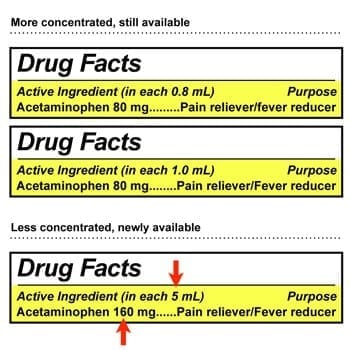Has the conversion of electronic medical record keeping led to the clinician blindly trusting what is portrayed on the screen? Regardless of the tools available, clinical judgment remains vital in providing medical care. I was working in the emergency department when I noticed a RN had given an overdose of acetaminophen (the active ingredient in Tylenol®) to a three year old child. The child was brought in for a high fever, which is what originally led to the administration of acetaminophen. The medication error was multifactorial, resulting from the triage nurse entering the patient weight incorrectly; to the physician entering the order for the incorrect dose based on the entered weight; and finally the nurse administering the incorrect dose to the child.
The weight entered for the child was not converted from pounds to kilograms (ex. the child weighed 37 lbs., which was entered as 37 kg, not 16.8 kg). When it comes to weight-based dosing of medications, kilograms is the unit of choice. Failure to properly convert from pounds to kilograms can lead to significant dosing errors, which can result in potential harm.
When the RN was confronted as to what happened, her reply was “well the computer screen said the patient weighed 37 kg, so I gave the dose based on that”. As a clinical pharmacist and a father, without doing any basic arithmetic, when I see a dose of 550 mg of acetaminophen for a 3 year old child, it is not hard to determine that might be incorrect and warrant a review.
Dosing of acetaminophen in children is based on weight and age. The usual dose is 10 – 15 mg/kg given every 4 to 6 hours. Children aged 2 – 6 years should not receive more than 5 doses in a 24 hour period. Pediatric acetaminophen is available as an oral suspension, chewable tablet or suppository. In December 2011, the FDA released a statement regarding the new dose formulation of pediatric acetaminophen, which was being changed from 80 mg/0.8 mL to the new formulation of 160 mg/5 mL. It is very important to read the drug label in the section labeled “Active ingredient” to ensure that you are giving the proper dose. As a father and clinical pharmacist, and from my experience with my patients and even my 2 ½ year old daughter, giving either a suppository or using a dosing syringe helps make things simple.
For consumer information on safe acetaminophen administration here are some helpful links:
- http://www.fda.gov/ForConsumers/ConsumerUpdates/ucm284563.htm
- http://on.aol.com/video/tylenol-troubles–150-americans-die-yearly-from-acetaminophen-overdose-518149698
Ultimately, what is important is we as health care providers and parents at home must remain vigilant to all aspects of clinical care. Mistakes can happen when we let our guard down, and we owe it to our patients, children, and even ourselves to always pay attention to detail and focus on doing the right thing.
Submitted by:
Dr. Ayad Shuaib, PharmD -PGY1 Pharmacy Practice Resident in collaboration with Donna M. Lisi, PharmD, BCPS, BCPP
Clara Maass Medical Center
Thanks for reading! I’m giving away a 6 page PDF on 30 medication mistakes I see in my practice, please take advantage of the free and unique opportunity for subscribers! – Eric Christianson, PharmD, CGP, BCPS




0 Comments